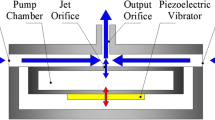Abstract
Hydropneumatic transformer (short for HP transformer) is used to pump pressurized hydraulic oil. Whereas, due to its insufficient usage of energy and low efficiency, a new kind of HP transformer: EEUHP transformer (Expansion energy used hydropneumatic transformer) was proposed. To illustrate the characteristics of the EEUHP transformer, a mathematical model was built. To verify the mathematical model, an experimental prototype was setup and studied. Through simulation and experimental study on the EEUHP transformer, the influence of five key parameters on the output flow of the EEUHP transformer were obtained, and some conclusions can be drawn. Firstly, the mathematical model was proved to be valid. Furthermore, the EEUHP transformer costs fewer of compressed air than the normal HP transformer when the output flow of the two kinds of transformers are almost same. Moreover, with an increase in the output pressure, the output flow decreases sharply. Finally, with an increase in the effective area of hydraulic output port, the output flow increases distinctly. This research can be referred to in the performance and design optimization of the EEUHP transformers.
Similar content being viewed by others
References
T. M. West and D. E. Kennedy, Air driven hydraulic pump: U.S. Patent 7,168,928, 2007-1-30.
C.-H. Lu and Y.-R. Hwang, Modeling of an air motor servo system and robust sliding mode controller design, Journal of Mechanical Science and Technology, 26 (4) (2012) 1161–1169.
L. Xuemei and D. Feng, The study and application of pneumatic hydraulic cylinder, Fluid Power Transmission and Control, 6 (2004) 24–25.
X. H. W. S. Z. Keding, Pneumo-hydraulic system and the pneumatic hydraulic combination control (PHCC) system, Chinese Journal of Mechanical Engineering, 7 (2001) 023.
J. A. Murray, R. E. Clouse and J. L. Conklin, Components of the standard oesophageal manometry, Neurogastroenterology & Motility, 15 (6) (2003) 591–606.
A. Shahab and G. Lindberg, Electrogastrography: poor correlation with antro-duodenal manometry and doubtful clinical usefulness in adults, World Journal of Gastroenterology, 13 (38) (2007) 5101.
H. Yan, N. Yanchun and L. Haotang, The structure of liquid pressure cylinder principle and application, Hydraulics Pneumatics & Seala, 11 (2011) 73–75.
R. Ramakrishnan, S. S. Hiremath and M. Singaperumal, Theoretical investigations on the effect of system parameters in series hydraulic hybrid system with hydrostatic regenerative braking, Journal of Mechanical Science and Technology, 26 (5) (2012) 1321–1331.
J. H. Jeong and S.-G. Park, D. Sarker and K. S. Chang, Numerical simulation of the effects of a suction line heat exchanger on vapor compression refrigeration cycle performance, Journal of Mechanical Science and Technology, 26 (4) (2012) 1213–1226.
M. Cai, K. Kawashima and T. Kagawa, Power assessment of flowing compressed air, Journal of Fluids Engineering, 128 (2) (2006) 402–405.
Y. Shi and M. Cai, Working characteristics of two kinds of air-driven boosters, Energy Conversion and Management, 52 (12) (2011) 3399–3407.
K. Oneyama, T. Takahashi, Y. Terashiona, K. Kuroshita and T. Kagawa, Study and suggestion on flow-rate characteristics of pneumatic components, Proc. 7th Triennial International Symposium on Fluid Control, Measurements and Visualization, Sorrento, Italy (CD-ROM) (2003).
B. Xu et al., An energy-saving hydraulic servo system with safety consideration for pipe fatigue tests, Proceedings of the Institution of Mechanical Engineers, Part I: Journal of Systems and Control Engineering (2014) 486–499.
S. K. Mathanker et al., Stem bending force and hydraulic system pressure sensing for predicting napiergrass yield during harvesting, Computers and Electronics in Agriculture, 111 (2015) 174–178.
W. S. Chung, H. S. Song, D. H. Jung and T. W. Park, Development of a systematic process for hydraulic brake system design and for hot judder characteristic estimation, Journal of Mechanical Science and Technology, 26 (12) (2012) 3893–3901.
S. Yan and M. Cai, Dimensionless study on output flow characteristics of expansion energy used pneumatic pressure booster, Journal of Dynamic Systems, Measurement, and Control, 135 (2) (2013) 021007.
Y. Shi, M. Cai, W. Xu and J. Lü, Flow characteristics of expansion energy used pneumatic booster, Chinese Journal of Mechanical Engineering, 25 (5) (2012) 889–896.
Y. Shi and M. Cai, Working characteristics of two kinds of air-driven boosters, Energy Conversion and Management, 52 (12) (2011) 3399–3407.
Author information
Authors and Affiliations
Corresponding author
Additional information
Yan Shi is an associate professor of School of Automation Science and Electrical Engineering, Beihang University, Beijing, China. He received his doctor degree in mechanical engineering from Beihang University. His research interests include intelligent mechanical devices and energy-saving technologies of pneumatic system.
Tiecheng Wu was born in 1991. Now he is a master at School of Automation Science and Electrical Engineering, Beihang University, China. He received his bachelor degree from Yanshan University, China in 2014. His research interests include power transmission and motion control.
Maolin Cai is a professor of School of Automation Science and Electrical Engineering, Beihang University, Beijing, China. He received his doctor degree in Tokyo Institute of Technology. His research interests include energy saving, measurement, simulation and control of pneumatic system, Research on the technology of high efficiency and large scale compressed air energy storage and so on.
Chong Liu is a post doctor of school of Automation Science and Electrical Engineering, Beihang University, Beijing, China. He received his doctor degree in mechanical engineering from Beihang University. His research interests include Energy storage and Intelligent distributed integrated energy system.
Rights and permissions
About this article
Cite this article
Shi, Y., Wu, T., Cai, M. et al. Modelling and study on the output flow characteristics of expansion energy used hydropneumatic transformer. J Mech Sci Technol 30, 1163–1170 (2016). https://doi.org/10.1007/s12206-016-0220-8
Received:
Revised:
Accepted:
Published:
Issue Date:
DOI: https://doi.org/10.1007/s12206-016-0220-8



